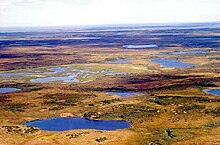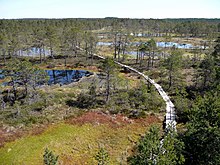
Back منظر طبيعي Arabic Landşaft Azerbaijani Геаграфічны ландшафт Byelorussian Ландшафт Bulgarian Pejzaž BS Paisatge (geografia) Catalan Krajina Czech Ландшафт CV Landskab Danish Landschaft German
A landscape is the visible features of an area of land, its landforms, and how they integrate with natural or human-made features, often considered in terms of their aesthetic appeal.[1] A landscape includes the physical elements of geophysically defined landforms such as mountains, hills, water bodies such as rivers, lakes, ponds and the sea, living elements of land cover including indigenous vegetation, human elements including different forms of land use, buildings, and structures, and transitory elements such as lighting and weather conditions. Combining both their physical origins and the cultural overlay of human presence, often created over millennia, landscapes reflect a living synthesis of people and place that is vital to local and national identity.
The character of a landscape helps define the self-image of the people who inhabit it and a sense of place that differentiates one region from other regions. It is the dynamic backdrop to people's lives. Landscape can be as varied as farmland, a landscape park or wilderness. The Earth has a vast range of landscapes including the icy landscapes of polar regions, mountainous landscapes, vast arid desert landscapes, islands, and coastal landscapes, densely forested or wooded landscapes including past boreal forests and tropical rainforests and agricultural landscapes of temperate and tropical regions. The activity of modifying the visible features of an area of land is referred to as landscaping.
- ^ New Oxford American Dictionary.







